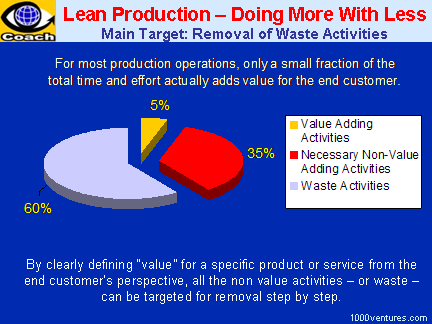
→
Lean Enterprise:
Kore 10 Tips
 Example of a Lean Value Chain
Example of a Lean Value Chain
|
-
Employee
Involvement and
→
Empowerment
– organizing workers by forming teams and
giving them training and responsibility to do many specialized
tasks, for housekeeping, quality inspection, minor equipment
repair and rework; allowing also them time to meet to discuss
→
problems
and find ways to improve the process
→
Continuous Improvement Mindset
-
Reduced Setup Cost and
Times (for semi-versatile
machinery such as big stamping presses)
– from months to hours thus making
small-lot production economically viable; achieved by organizing
procedures, using carts, and training workers to do their own setups,
-
Small-Lot
Production
– allowing higher
→
flexibility
and pull production (or
just-in-time manufacturing)
-
Quality at the
Source
–
→
total quality management (TQM)
and control; assigning workers, not inspectors, the
responsibility to discover a defect and to immediately fix it;
if the defect cannot be readily fixed, any worker can halt the
entire line by pulling a cord (called jidoka)
-
Pull Production,
or Just-In-Time (JIT)
– the method wherein the quantity of work
performed at each stage of the process is dictated solely by the
demand for materials from the immediate next stage; thus
reducing waste and lead times, and eliminating inventory holding
costs
>>>
-
Continuous
Equipment Maintenance
– as pull production reduces inventories,
equipment breakdowns must also be reduced; thus empowered
operators are assigned primary responsibility for basic
maintenance since they are in the best position do detect signs
of malfunction
-
Multi- Skilled
Workforce
– as employees are empowered to do many
jobs, they must be provided with adequate training
-
Supplier
Involvement
– the manufacturer treats its
supplier as a long-term partners; they often must be trained
in ways to reduce setup times, inventories, defects, machine
breakdowns, etc. in order to enable them to take responsibility
for delivering the best possible parts/services to the
manufacturer in a timely manner.
→
Toyota Production System
→
The Toyota Way:
14 Principles |